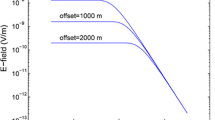Extensive observation examples have verified that the processes of earthquake development and occurrence are accompanied by seismic electromagnetic anomalies. Some of the electromagnetic emission phenomena, such as seismo-electromagnetic signals, electro-kinetic emission near the water driven front in oil reservoirs and low frequency leaking signals from deep based protective engineering, can be treated as the low frequency vector electric dipole source underground. In this study, the equivalent electric dipole generated by the seismic electromagnetic anomaly in a homogeneous Earth was numerically simulated, focusing on the spatial distribution characteristics of the electric dipole source response in any direction in the Earth. By simulating the dipole source responses for different sources and geoelectric parameters, the distribution characteristics of the electric dipole source response in the Earth was analyzed and discussed. The results of this analysis provide a basis for the observation, identification, processing, and interpretation of seismic electromagnetic signals. Information about seismo-electromagnetic source distribution and time variation can be used for evaluating possible earthquake hazard as well as to study the machanism and time evolution patterns of seismogenic process.






Similar content being viewed by others
References
Xuemin Zhang, Guoze Zhao. Foreign seismic electromagnetic phenomenon observation [J]. Geophysics Progress, 2007, 22(3): 687-694.
Jijun Wang, Guoze Zhao. Observation and Research of Seismic Electromagnetic Phenomenon in China [J]. Geodesy and Geodynamics, 2005, 25(2): 11-21.
Siddique Md Nurul Islam, Munaim Mimi Sakinah Abdul, Wahid Zularisam Bin Abdul. The combined effect of ultrasonic and microwave pre-treatment on bio-methane generation from co-digestion of petrochemical wastewater [J]. Journal of Cleaner Production, 2017, 145: 303-309.
Monali Priyadarshini, Azhan Ahmad, Sovik Das, Makarand Madhao Ghangrekar. Application of microbial electrochemical technologies for the treatment of petrochemical wastewater with concomitant valuable recovery: A review [J]. Environmental Science and Pollution Research, 2022, 29(41): 61783-61802.
Jinqi Hao, Shuqing Qian, Jintian Gao. Low Frequency Electromagnetic Anomaly During Rock Rupture [J]. Seismology Journal, 2003, 25(1): 102-111.
Singh Pardeep, Borthakur Anwesha. A review on biodegradation and photocatalytic degradation of organic pollutants: A bibliometric and comparative analysis [J]. Journal of Cleaner Production, 2018, 196: 1669-1680.
Ichi Takumi, Masahiko Nagai, Shinji Kato, Masayasu Hata, Hiroshi Yasukawa. Estimation of EM radiation source location from 233Hz EM field power data at multiple spots [J]. Geoscience and Remote Sensing Symposium, IEEE International, 2001, 7: 391-391.
Ichi Takumi, Shuhei Murakami, Ichi Takumi, Masayasu Hata, Hiroshi Yasukawa. Clustering of EM radiation source based on eigenvector [J]. Geoscience and Remote Sensing Symposium, IEEE International, 2002, 5: 2614-2616.
Aimin Du, Qinghua Huang, Shaofeng Yang. Epicenter location by abnormal ULF electromagnetic emissions [J]. Geophysical Research Letters, 2002, 29(10): 1455.
Bei Zhang. The method of seismic electromagnetic wave reverse track and wave source location [D]. The Graduate School of CAS [PhD thesis], 2010: 48-54.
Boudries R., Khellaf A., Aliane A., Ihaddaden L., Khida F. PV system design for powering an industrial unit for hydrogen production [J]. International Journal of Hydrogen Energy, 2014, 39(27): 15188-15195.
Huaping Guan, Guiping Liu. Research the Relationship Between Electromagnetic Radiation Anomaly Before the Earthquake with Earthquake [J]. Seismology Journal, 1995, 17(2): 237-246.
Qinghua Huang. Seismic Electromagnetic observation research description [J]. National Seismic Dynamics, 2005, 11: 2-5.
Yang Feng, Guoqi Yang, Yintao Li, Hongqiang Guo, Min Du, Xin Liu, Shan Liu, Ming Wen, Qiangqiang Yang, Qiang Wei, Lei Liu, Ting Lu. Experiment of microscopic water flooding seepage law and remaining oil occurrence state based on sandstone core model [J]. Unconventional Oil & Gas, 2022, 9(04): 98-106.
Faerber Christian, Stegner Philipp, Zenneck Ulrich, Knuepfer Christian, Bendt Georg, Schulz Stephan, Harder, Sjoerd. Teaming up main group metals with metallic iron to boost hydrogenation catalysis [J]. Nature Communications, 2022, 13(1): 3210.
Alimardanov Hafiz M., Suleymanova Elmira T., Garibov Neymat I., Musayeva Elnara S. liquid-phase catalytic oxidation of styrene and its derivatives into oxygen-containing compounds [J]. Processes of Petrochemistry and Oil Refining, 2022, 23(3): 472-494.
Khan Salman, Wong Kainam Thomas. A Six-Component Vector Sensor Comprising Electrically Long Dipoles and Large Loops-To Simultaneously Estimate Incident Sources’ Directions-of-Arrival and Polarizations [J]. IEEE Transactions on Antennas And Propagation, 2020, 68(8): 6355-6363.
Yaohuang Luo, Dexiu Bao, Yonghan Wu. Electromagnetic field of vertical electric dipole was motivated in three layer medium. Journal of Yunnan University (Natural Science Edition), 1996, 18(3): 209-215.
Helbig Christoph, Gemechu Eskinder D., Pillain Baptiste, Young Steven B., Thorenz Andrea, Tuma Axel, Sonnemann Guido. Extending the geopolitical supply risk indicator: Application of life cycle sustainability assessment to the petrochemical supply chain of polyacrylonitrile-based carbon fibers [J]. Journal of Cleaner Production, 137: 1170-1178.
Cuevas Nestor H., Alumbaugh David. Near-source response of a resistive layer to a vertical or horizontal electric dipole excitation [J]. Geophysics, 2011, 76(6): 353-371.
Acknowledgements
This research was financially supported by the National Natural Science Foundation of China Project "Detection and Inversion of Non-Uniform Low-Frequency Electromagnetic Radiation Source" (No.41574064).
Author information
Authors and Affiliations
Corresponding author
Additional information
Translated from Khimiya i Tekhnologiya Topliv i Masel, No. 3, pp. 137–143 May – June, 2023.
Rights and permissions
Springer Nature or its licensor (e.g. a society or other partner) holds exclusive rights to this article under a publishing agreement with the author(s) or other rightsholder(s); author self-archiving of the accepted manuscript version of this article is solely governed by the terms of such publishing agreement and applicable law.
About this article
Cite this article
Guo, H., Hu, H. & Hu, W. Simulation of Vector Electric Dipole Source Response in Homogeneous Earth for Petrochemical Resource Exploration. Chem Technol Fuels Oils 59, 606–616 (2023). https://doi.org/10.1007/s10553-023-01561-1
Published:
Issue Date:
DOI: https://doi.org/10.1007/s10553-023-01561-1




